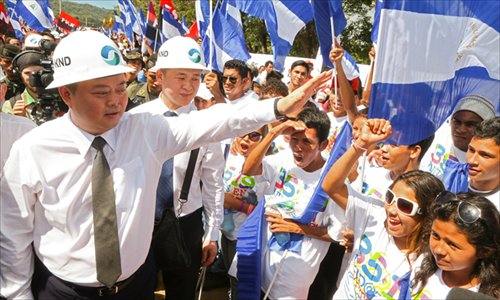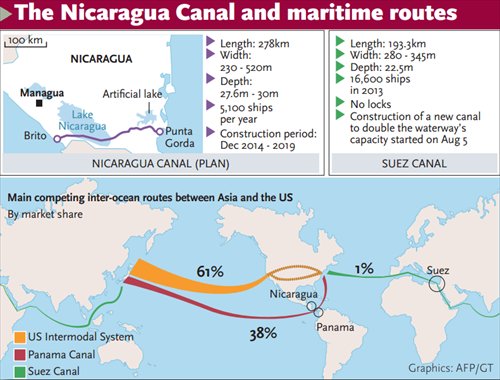Nicaragua Canal underway
Chinese magnate rebuffs environmental, relocation concerns

Chinese businessman Wang Jing (left) of HKND Group greets members of the Sandinista National Liberation Front during the inauguration of an inter-oceanic canal in Tola, some 3 kilometers from Rivas, Nicaragua, on Monday. The $50 billion canal across Nicaragua is expected to rival the Panama Canal. Photo: AFP

Graphics: AFP/GT
The ambitious $50 billion Nicaragua Canal project backed by a Chinese company to link the Pacific Ocean and the Caribbean Sea that was officially launched Monday is set to break the current bottleneck in international trade, said analysts.
The 278-kilometer canal, being built in south Nicaragua by the Hong Kong-based Nicaragua Canal Development Investment Co, (HKND Group), will be the largest infrastructure megaproject in Latin America and will rival the Panama Canal when completed in 2019.
The new canal will be able to accommodate ships with a displacement of 400,000 tons, while the Panama Canal can only accommodate ships with a displacement of 90,000 tons, Wang Jing, chairman and CEO of HKND Group, told the Global Times.
"The common problem faced by both the Panama and Suez canals, two of the world's biggest, is that their width limits their cargo volume," said Wang. "Even after the Panama Canal expansion in 2016, it can only accommodate ships of up to 150,000 tons."
Shipping experts have said the new Nicaragua Canal will become a new driver of international trade, as well as give a much-needed boost for the Nicaraguan economy, the second-poorest country in the Americas after Haiti.
"The current Panama Canal can no longer satisfy the demands of the growth in world trade, especially from East Asia to countries like Brazil and South Africa," Zhang Yongfeng, a market analyst with Shanghai International Shipping Institute, told the Global Times.
Zhang said the mega project, as part of China's "Go Out policy" as the world's biggest trading nation, will increase trade with Caribbean nations and the US.
The new canal will also better connect Nicaragua with the world and increase its national and international trade. Nicaraguan Vice President Omar Halleslevens said at a groundbreaking ceremony Monday in the southern town of Rivas that the new waterway is expected to raise the nation's GDP growth from about 4-5 percent to 8-10 percent.
Western media, however, have focused on opposition to the project. Sporadic protests broke out as early as 2013, reports said. Residents in the area to be affected worry about being displaced by the canal which will cut through the country, while environmentalists are concerned the large-scale project might harm local ecosystems.
Wang promised Monday that all relocations will only be made with the consent of the people affected. The staff of HKND Group told the Global Times that they have not encountered much opposition as they approach the people affected, as most of the residents supported the project as a chance to improve their lives.
The route of the canal linking the Atlantic and Pacific oceans will pass through Nicaragua Lake, a more than 8,000-square kilometer body of freshwater that is Central America's biggest lake and the 19th largest in the world.
The canal's final route will create the least pollution among all six proposed routes, taking into consideration the project's impact to the area's geology, water quality, and the general public, HKND said.
Wang said that an extra $8 billion was poured into minimizing its environmental impact, and the company will finish an environmental impact assessment report by the first quarter of 2015.
He downplayed media reports that the China-backed canal will ruffle feathers in the US, as it is being built in its traditional sphere of influence and will compete with the US-backed Panama Canal.
Wang admitted there could be competition among the two canals, but said he believes they can be complementary to each, as they will serve different markets.
The Panama Canal is still the shorter route, at 77 kilometers, but lies further south of the new canal. It opened in 1914, and was taken into full Panamanian control in 1999.
"The US will not let politics affect economic cooperation, as it will also benefit from the new waterway too," Li Zhenfu, a professor with Dalian Maritime University, told the Global Times.
HKND Group has obtained the exclusive right to develop and manage the canal for 100 years, and will work with a few Chinese companies in its investment.
The company will take all the revenue in the first 10 years after operation. Its share will decrease to 90 percent from the 11th to the 20th year, and the percentage will continue to drop every decade, until the `n government receives all the revenue after 100 years.